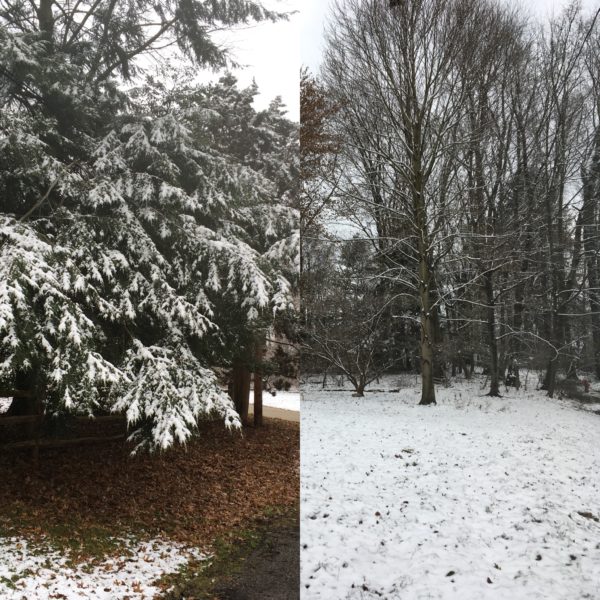Conifers capture the snow, but do they intercept it?
Cross-posted at Highly Allochthonous

Conifers (left) capture much more snow than grass (right foreground) or deciduous forest (right background). But will they keep the ground dry all winter? (Photo by A. Jefferson, 2017)
If you’ve walked through the forest on a rainy day and noticed that it’s drier under the trees, you’ve experienced interception.
In hydrology, interception is when water gets hung up on vegetative leaves, needles, or branches and never makes it to the ground. The precipitation gets evaporated (if liquid) or sublimated (if solid) back into water vapor directly from the vegetative surface before it gets a chance to hit the ground and infiltrate or run off. (If the water hangs out in the vegetation for a while but eventually makes it to the ground, we call it stemflow or throughfall depending on whether it ran down the tree trunk or not.)
Interception can be a pretty significant component of the water budget. In forests, the vegetation can intercept 20-40+% of precipitation. In grasslands, the numbers are in the 10-20% range. Even litter, the dead plant material covering the soil, can cause interception. Interception rates depend on plant type and density, but also how much rain you get, how fast it falls, and how much evaporation can occur during and between storms.
In the winter, interception still happens during snowfall, but now vegetation type really matters. Since deciduous trees shed their leaves in the winter, they become pretty useless for interception. In the picture above, you can’t really see the difference between the deciduous forest and the lawn — they are both fully snow-covered. On the other hand, since conifers retain their needles, they can capture a lot of snow — and you can see that in the bare ground under the trees at left.
Whether the conifers truly intercept all that snow is more complicated. Conifers can initially hold large snow loads, but wind can blow that snow onto the ground, it can be dumped off in large clumps, and melting within the snowpack on the branches can allow the water to drip to the ground. In order to effectively intercept the water and return it to the atmosphere, we’d need sublimation to happen faster than those other processes. But does that happen?
In a study in Oregon’s Umpqua National Forest (Storck et al., 2002), mature conifers initially captured up to 60% of the snowfall (up to at least 40 mm). When conditions were warm and conducive to snowmelt after the snowstorm, 70% of the water left the canopy as meltwater drip and 30% left as masses of snow falling to the ground. Only if the weather remained below freezing after snowfall, could sublimation work to reduce the snow storage in the trees. But that goes slowly, at an average rate of ~1 mm/day. If the weather got above freezing, then melting and dumping took over. Overall, the study site got about 2000 mm of precipitation in the winter and the ground in the forested areas experienced about 100 mm less than the ground in the open areas, giving a winter interception rate of about 5%.
Of course, that’s only one study and other modeling and experimental work adds more nuance and complication. Climate and solar radiation affect sublimation rates. Canopy density affects sheltering by wind and interception. And more. High spatial resolution modeling of two sites in Colorado and New Mexico gives interception values of 19% and 25%, respectively (Broxton et al., 2015). When they consider all of the processes happening to redistribute snow around a patchy forest, they conclude that the driest areas are under tree canopies and the wettest areas are <15 m from the edge of the canopy. If you get farther out into an open area, it gets drier again, though not as dry as under the forest cover. And the differences are not small, snow water input can be 30-40% higher near the edge of the canopy than underneath it.
So next time you walk through a forest in the rain or snow, be impressed by the hydrologic work the trees are doing to keep you dry, and know that interception adds up to a significant amount of water. But if it's a warm winter day, don't be surprised to feel a cold meltwater drip from the pine tree above you -- or get a load of snow dumped on your head -- because even conifers can't hang onto the snow long enough to keep the ground dry forever.
Read more:
Broxton, P. D., Harpold, A. A., Biederman, J. A., Troch, P. A., Molotch, N. P., and Brooks, P. D. (2015) Quantifying the effects of vegetation structure on snow accumulation and ablation in mixed-conifer forests. Ecohydrol., 8: 1073–1094. doi: 10.1002/eco.1565. (pdf available via ResearchGate)
Storck, P., D. P. Lettenmaier, and S. M. Bolton, Measurement of snow interception and canopy effects on snow accumulation and melt in a mountainous maritime climate, Oregon, United States, Water Resour. Res., 38(11), 1223, doi:10.1029/2002WR001281. (open access)
